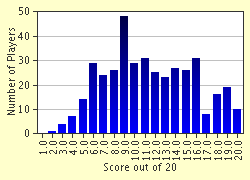Quiz Answer Key and Fun Facts
1. On what island in the Central Pacific did US Marines make an heroic stand in December 1941?
2. On what date did combined Japanese land, air, and naval forces assault the Philippine Islands?
3. Which US General was the overall commander of US Army, Navy,
and Air Corps personnel in the Philippines when the Japanese invasion occurred?
4. Dive bomber pilots from which US aircraft carrier drew first blood against two of the Japanese carriers at the Battle of Midway?
5. When did the Battle of Midway occur?
6. Name the 4 Japanese carriers that were sunk during the Battle of Midway.
7. Name the one US Navy carrier lost to attacks by Japanese planes and later a submarine during the Battle of Midway.
8. What 'watershed' event for US Ground Forces took place in the South Pacific in early August 1942?
9. What was the name of the US airfield on Guadalcanal?
10. What was the front-line fighter flown by US Navy and Marine pilots throughout 1942?
11. What was the nickname used by the Marines to describe the Japanese ships that supplied Japanese forces in and around the Solomon Islands, and also New Guinea?
12. Name the Commander-in-Chief of all US Forces in the Central Pacific Theater of Operations:
13. In 1943, US Marines spent three bloody days taking Tarawa, a small group of islets. Name the largest island where most of the fighting took place.
14. Please name the island in the Marianas taken by US Marines and Army personnel in 1944 on which Japanese soldiers and civilians committed suicide by jumping off 600-foot bluffs overlooking the Pacific.
15. Gen. Douglas MacArthur fulfilled his pledge ('I shall return.') to the Filippino people when he stepped ashore on which Philippine island in October of 1944?
16. During the Battle of Leyte Gulf, which US admiral was completely fooled by the Japanese into leaving the San Bernadino Strait unguarded when he raced north to engage a decoy force of Japanese carriers?
17. 'The Battle of the Philippine Sea' was one of the largest air battles of the Pacific War. In it, Japanese carrier air power was destroyed. What is the more popular nickname of this battle?
18. Name the battle at which the Japanese first used organized 'kamikaze' attacks.
19. Which of the following islands in the Pacific took the US Marines or combined Marine and Army Forces the longest to secure?
20. Please name the US Army Air Corps pilot who dropped the first atomic bomb on Japan.
Source: Author
dmiles54
This quiz was reviewed by FunTrivia editor
bloomsby before going online.
Any errors found in FunTrivia content are routinely corrected through our feedback system.

